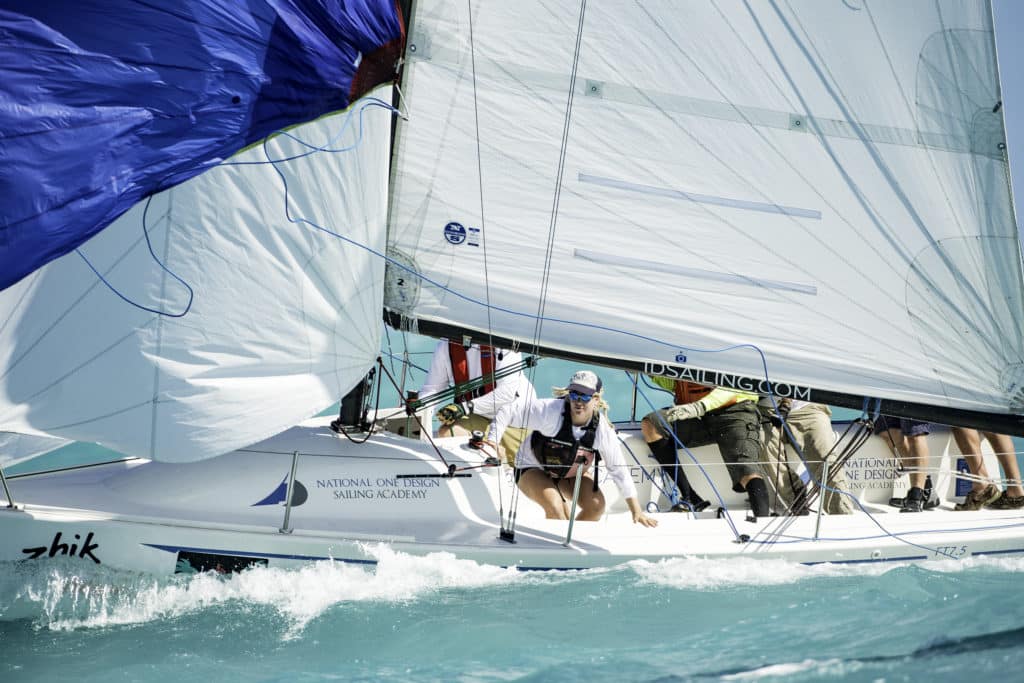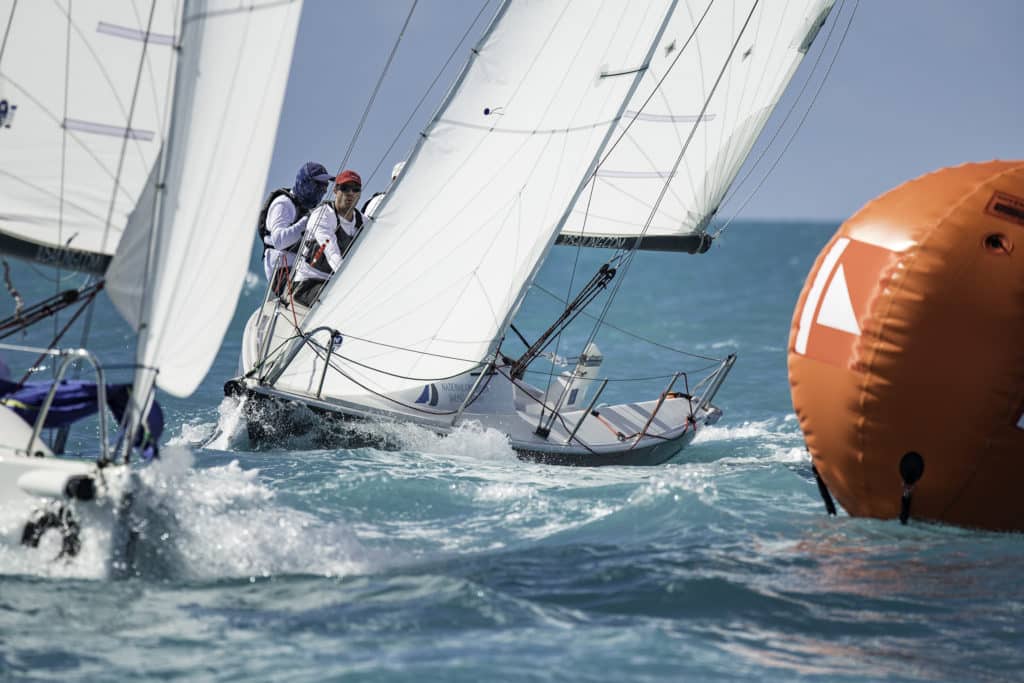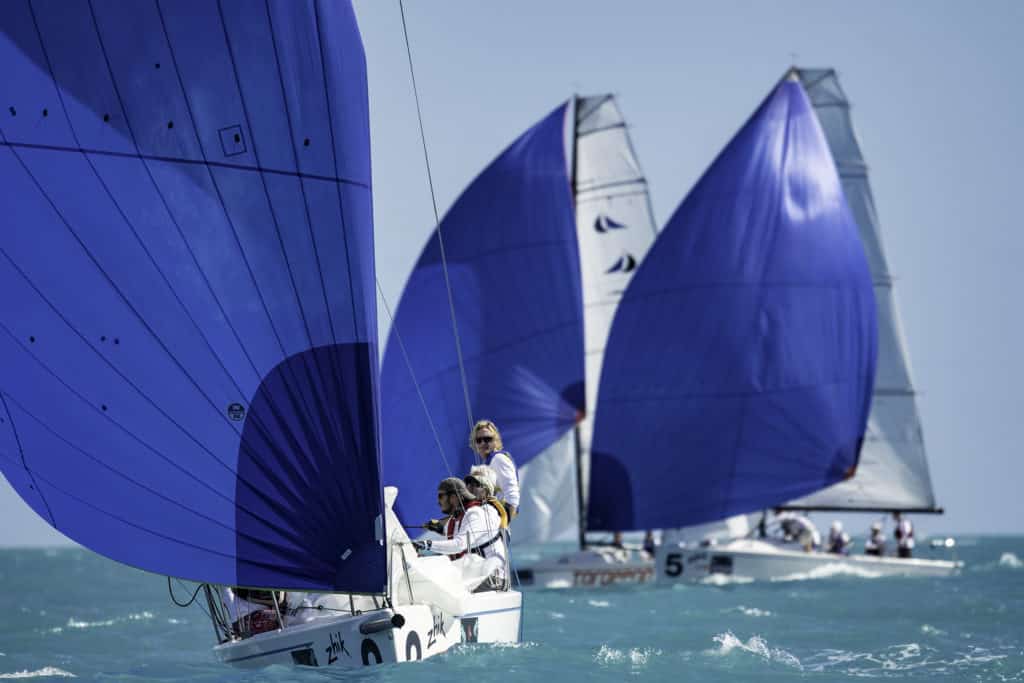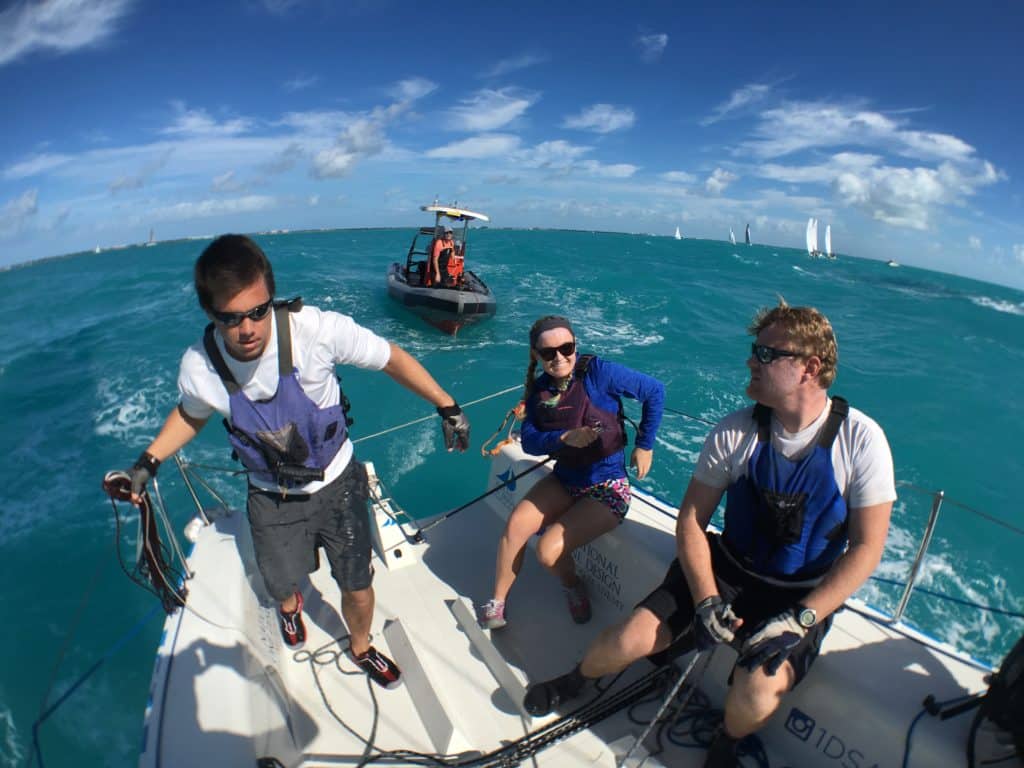
It’s early morning in Key West — golden and warm as the RV encampment known as Tiger Town stirs from its slumber. Roosters crow in the distance, barely audible over the diesel generator chugging away behind a half-dozen motorhomes from Cruise America. Soon, electric skillets in the outdoor galley will sizzle with bacon and eggs, luring bleary-eyed sailors and coaches out of their bunks.
Dave Smith, the unofficial mayor of Tiger Town, is pacing the compound with a cup of coffee his neighbor just brewed. “He’s always up first,” says Smith, flashing a broad smile, “so his is now the coffee camper. Want a cup?”
Smith is here representing the National One Design Sailing Academy, an upstart sailing school based in Toronto, Canada, and this village is essentially his doing. The inhabitants, three or four to an RV, include a handful of academy employees, Smith’s friends, and a few sailors and coaches. Nearby in the Truman Annex basin are seven of the academy’s Flying Tiger 7.5s, 25-foot one-designs built in China. Smith and his buddies have towed the boats to Key West for teams to charter for Quantum Key West Race Week, in collaboration with NorthU’s Regatta Experience, which includes three days of clinics and practice, followed by five days of races with coaches on board and post-race classroom sessions.
Using the Flying Tigers at the sailing school in Toronto only three months out of the year doesn’t make financial sense, Smith explains, so one alternative is to bring the boats south to bucket-list regattas on the East Coast and put sailors into them. A sold-out NorthU training week in Toronto the year before is what ultimately gave Smith and his team the gumption to set the migration in motion. Others will follow in Florida, South Carolina and Maryland. Or at least that’s the plan.
“I’m not a rich guy, maybe just a little crazy,” he says while explaining the financials of the operation. “My wife keeps reminding me that the pot is not bottomless.”
Crazy, perhaps, but Smith’s altruistic motivation is to pipeline more young-adult sailors into keelboat racing. Starting in December 2016, he personally towed eight of the boats behind his Chevy Avalanche, from Toronto to Atlanta, driving 24,000 round-trip miles in less than two months. In early January, his academy entourage rented the RVs from Cruise America in Atlanta and convoyed to the Conch Republic where they then launched, rigged, and prepped the boats for charter teams and NorthU attendees to plug and play.
Storm Trysail Club — the organization that runs Race Week and is keen to bolster entries — has pulled local strings in order to squeeze the caravan onto a dusty vacant lot littered with boat trailers and shipping containers. They’ve plumbed water to the RVs, provided a generator and nightly diesel top-offs, and arranged for a daily pump-out truck.

“There’s no water view, which would be nice, but it’ll do,” says Smith.
Bill Gladstone, NorthU’s bespectacled professor, describes it as “glamping, at its best.” Outside Gladstone’s deluxe accommodations in the big bus is a pop-up North Sails tent filled with collapsible camp chairs. It’s his classroom for pre- and post-race debriefs, as well as Tiger Town’s communal space.
Across the street and behind a row of tall palms are Truman Annex’s vacation condos, filled with other Race Week crews. Each morning and afternoon, professional sailors commute to their grand-prix raceboats berthed around the corner, passing by on bikes, skateboards and scooters. With a good night’s rest and bellies full of chef-prepared team breakfasts, they blithely pass by this shantytown of sailors paying their own way to play in this winter sailing paradise. While a clean, air-conditioned condo for the week would be nice, these Tiger sailors are barely home anyway. Harbor starts are at 0900, and last call at the nearby Green Parrot Bar is as late as one dares.
Of the seven competing teams, three are part of the Gladstone’s NorthU Regatta Experience. Brian Tyrell’s Melges 24 team from Washington has chartered a Tiger from the academy because their class was nixed by organizers after they’d already paid for flights and accommodations. There’s skipper Nigel Brownett, who’s chartered one as well. His foursome stands out in matching gray shirts with “Hogfish Racing” screened across the back. They’ve sailed together before, and many times in Key West.
At the urging of Storm Trysail Club, a sixth boat has been given to students from a local sailing school, and the seventh Tiger is placed into the hands of a thrown-together entry of four youngsters, a coach and myself as a ride-along spinnaker trimmer.
On the mainsheet is Mays Dickey, a young lawyer from Alabama. His girlfriend, Laura Graham, a research associate and keelboat neophyte, will command the front of the boat, backed up by Elisabeth Whitener, a 23-year-old effervescent sailing instructor from North Carolina with hopes of being a pro sailor. North Sails designer Mike Marshall is moonlighting as our coach, and on the helm is 21-year-old All-American Rachel Bryer, of Jamestown, Rhode Island. This is her first regatta driving a sportboat.
Our hour-and-a-half commute to the racecourse on the first morning of the regatta — in 20 knots of breeze and steep, mushy waves, no less — is the first time we’ve ever sailed together. The same is true for a few of the other NorthU teams, so we’ll all be learning as we go. We use our commute to find the rhythm of the wind and waves, which sparkle a blinding white from the low and warm winter sun. Bryer is a smooth driver as a first-timer; her eyes fix on the little yarns twitching on the jib.
Dickey labors with the mainsheet; it creaks through the blocks every time he eases it. He grunts and grimaces as he tugs it tight again. Marshall, legs over the side, is the repetition in Bryer’s ear. “Whoa … falling over,” he calls whenever the boat heels too much. When we’re slow, it’s: “Too flat … waaay too flat.”

These are the honey sailing conditions that have lured sailors to Race Week for 30 years: brilliant sunshine, persistent winds and whitecapped waves for surfing. Our speed is good against every boat we line up with on our way out to the course, including Brownett’s Hogfish Racing. It’s no secret they’re the pace boat.
We check in with the race committee, wave hello, and start our upwind study of the racecourse. The plan is to sail the first beat, set the kite, knock off a few blow-through jibes, and then chill. But seconds into our exercise, the jib halyard cover parts with a bang, and the new sail becomes a limp mess of white cloth hanging from the forestay.
On any given race day, in any other fleet, we would’ve been done for, being so far from shore, but the academy’s roving support RIB is alongside us after a hail and retrieves our dearly departed halyard for an emergency splice. So we learn, the NorthU Regatta Experience includes roadside service.
Fortunately, we’re last in the five-fleet starting sequence, but as our class flag goes up, our chances are slipping away. At four minutes, Marshall tapes the spliced halyard to a tracer line and aloft it goes, disappearing into the mast. There’s hope, but he struggles to extract the halyard from the stainless-steel exit. It’s jammed inside the mast, and now it won’t go up or down. He grimaces, says there’s only one thing to do, tugs hard, and the rope goes limp in his hand. We weigh using the masthead spinnaker halyard, but Marshall isn’t interested in breaking the mast.
Retiring before starting a single race is a demoralizing way to begin a no-discard regatta, but our coach assures us it’s a long week with plenty of points to play for. We regroup, set the blue asymmetric, and practice our downwind technique over the long sail back to the harbor.
When the fleet returns to the basin two races later, with salt-caked sailors covered in bruises and with stories of other busted halyards, Marshall is already cutting new jib halyards for the entire fleet. The following morning, the academy’s pit crew doubles down, replacing everyone’s main halyard too. They’ve learned a valuable lesson in charter-fleet maintenance: Key West requires strong ropes and spare spools at the ready.
In our absence, Hogfish and Tyrell’s Melges 24 foursome establish the pecking order with a race win and a second-place for each of them. David Brockbank’s NorthU team on Boat No. 2 is buoyed with a pair of thirds.
The following morning, we shove off well before anyone else, eager to make up for lost time. With new halyards to crank bone-tight in the fresh conditions, we set sail to the racecourse as if it’s Race 1. For nearly two hours, we focus on the subtleties of feeling when the boat is “right” and when it’s slow.
“Use all your senses,” Marshall advises Bryer, his young grasshopper. “Feel the pressure on your butt when the boat heels, listen to the sound of the water rushing past the hull, the angle of the horizon. When it doesn’t feel right, think about what you have to do to reset.”
We put two second-place finishes on the scoresheet to Hogfish’s runaway race wins, and use every mile of our long sail to the harbor to further refine our downwind boathandling, with Bryer learning the art of the sportboat surf and the awkward wing-on-wing technique. By the time we turn the corner into the basin, we’re that much faster.

As part of our debrief, Marshall leads us through what he calls “one and one.” State one thing each of us felt we did well and one we’d like to improve upon. I praise the quality of my bailing all day: sponging at least 30 gallons of water from deep within the bowels of the boat. Tomorrow, though, I will bring a proper bailer.
At breakfast in Tiger Town, I score a perfect juice container from someone’s RV and craft the finest bailer. I take it as a sign it’s going to be a good day, and there’s an undeniable sense of purpose on our boat as we sail out into more benign conditions.
While we’ve gleaned a lot during our morning commutes, the day’s best insight instead comes during our long sail home, as we reflect on disappointing results. In one race we cough up a lead by getting slow, and in the second we botch a critical jibe, mere feet from the finish line, and allow Tyrell’s team on Boat No. 4 to snatch what could have — and should have — been a win. We finish the third race with a hard-fought second, but the disappointment of the first two is unsettling. Marshall instills in us the importance of resetting and moving on. For here, at the midpoint of the series, Hogfish is so far out front in the standings, we must turn our attention to the two boats within range. We’re only three points out of third, and it’s our time to make a move. He didn’t mean backward, though.
The following day, we have our worst finishes yet, a fourth and a sixth, which makes for one somber sail in. We shake it off later with a team dinner, Kraken Rum, and renewed outlook for the final day. We need to be better off the start, more aware of the fleet’s movements.
With the exception of a single fourth-place finish on account of their lifeline breaking earlier in the week, sending crewmembers into the drink, Hogfish has its picket fence, and in the light air, the foursome is untouchable going into the 10th and final light-air race.
We get a clean start, tack away, and appear to be making better progress to the mark, but when the first big windshift comes, we’re on the outside looking in. We kiss second overall goodbye and salvage the one point that will get us onto the awards stage to collect third-place hardware.
As we walk the stage later that night, smile for the cameras, and tear into the night, Smith’s team is back at the Annex deconstructing the boats for transit to the next stop of their northbound tour. While Smith is likely pondering his program’s success and whether he’s broken even or not, he has nevertheless succeeded in inspiring one of Gladstone’s disciples.
Sunburned, beaming and proudly clutching the silver plate her team has earned by finishing third in the final race, Canadian climate scientist Elizabeth Pattey says the experience was both humbling and incredibly rewarding. She’ll be back, roaring and ready to race.









